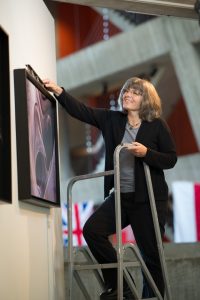How long have you worked at Fermilab?
I was hired in 2001, so around 16 years now. A series of my black and white photographs were featured in a group exhibit in the Fermilab Art Gallery in 1995. After that, I joined the Art Gallery Committee, and then this position came up and I was hired.
What do you do in your position here?
My official title is the visual arts coordinator, but my responsibilities are so varied. On any given day, I will be looking for people to exhibit their work in the Fermilab Art Gallery, researching online, meeting with the artists and visiting their studios. I work with a volunteer gallery committee who help make the decision on whose work to display and how best to display it, and assist with the installation too. I also run the Fermilab artist-in-residence program. Of course, there’s lots of paperwork and organization involved too. The exhibits change every two to three months, so the process is always ongoing.
How did you first get involved in art and photography?
I like being able to communicate visually. I photographed for my high school yearbook, and later studied at the Art Institute of Boston.
How has the art at Fermilab changed since you’ve been here?
When I first started at Fermilab, the displays were more traditional. Nowadays, they’re more intertwined with science. I feel like art is a great way to communicate science, especially to people who might not have a technical background.
What’s your favorite thing about working here?
I like working with colleagues and people that I would not usually meet. It gives me the opportunity to work with many artists and to really see and feel their work; it helps inspire mine too. Even without this job, I would go to art galleries and museums – that’s just who I am – but this job gives me an outlet to do what I love.
You were recently an artist-in-residence out-of-state. What did that involve?
I was selected to be artist-in-residence at Homestead National Monument in Nebraska during July. I continued to work on my project of identifying native prairie plants and making cyanotypes out of them. To do that, I complete a prairie quadrat study – identifying the prairie plants, both native and non-native in a given section of prairie – and then construct a grid of 25 cyanotypes, each 8×8 inches.
It was really interesting being on the other side of an artist-in-residence since I had founded the artist-in-residence program at Fermilab.
What do you do outside the lab?
I like being outdoors and with my family. Growing heirloom vegetables and cyanotyping, bike riding and photographing.




